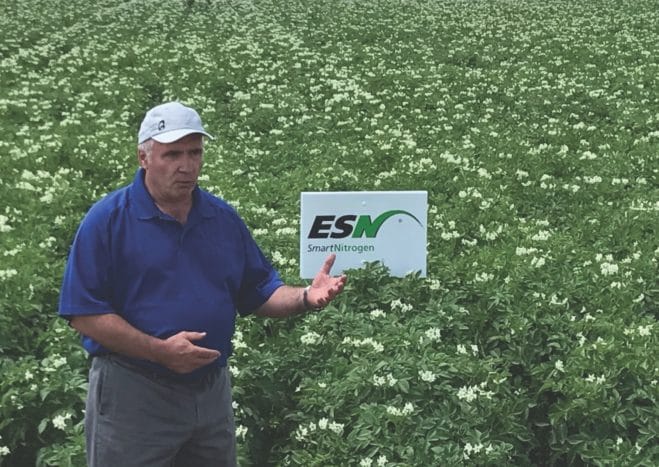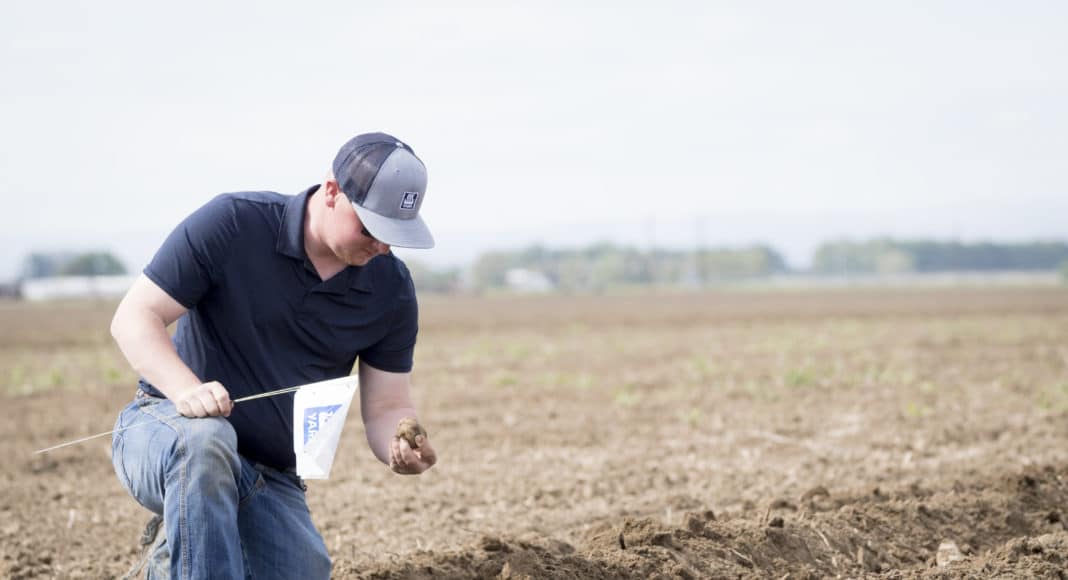Our experts
- Bryan Maynard, co-owner, Farmboys farm in Richmond, P.E.I.
- Alan Blaylock, senior agronomist with Nutrien
- From Yara:
- Shawn McIver, Maritimes regional sales manager
- Maarten de Voogd, global potato business manager
- Toby Goodroad, market development director for North America
- Brady Stover, sales agronomist, Washington region
- Murray Van Zeggelaar, vice-president, ALPINE in New Hamburg, Ont.
Experts review current trends and best practices to get the most out of using both forms of nutrient delivery.
Proper nutrient delivery is critical for maximized yield and quality in potatoes, and producers generally use both dry and liquid forms of fertilizer to accomplish this. However, what they choose to use and when depends on many factors, including cropping system (irrigated or not), what equipment they already have, availability of products and cost.
Experience is also an important part of the equation. Alan Blaylock, senior agronomist with Nutrien, notes potato growers are quite sophisticated in their crop management and have made personalized fertilizer application practices over many years. “Growers by and large are not inclined to make large changes in timing and placement as they don’t want to introduce unnecessary risk,” he says. “On the other side of the coin, because potatoes are such a high-value crop, growers are willing to invest in new application technologies and products and try some adjustments to maximize yields and quality.”
Another important piece of the puzzle in making decisions about liquid and dry fertilizer use is weather. “Weather patterns in our area of the country seem to be trending towards hotter, drier summers,” notes Bryan Maynard, co-owner Farmboys in Richmond, P.E.I.. “By ensuring that we break up the applications of fertilizer to our crop, we have a better chance of keeping the crop alive and healthy through the driest portion of the growing season.” Maynard and his family use both liquid and dry fertilizers, a dry application as a pre-plant broadcast and another dry one through the tubes of the planter. “We then top up our crop throughout the growing season with foliar fertilizer applications,” says Maynard, adding dry summer weather aside, “this ensures we not only get the best bang for our buck, but also that we limit the amount lost to leaching in the environment.”
Over the last few years, growers have been experiencing regular drought conditions and warmer daytime highs on the East Coast, Shawn McIver, Maritimes regional sales manager at Yara says. “This has led to growers ensuring that they go into the season with full nutrient solutions ensuring that they give their crop the best tools to override drought stress,” he says. “Some of these tools are the use of calcium and foliar nutrition. In the past number of years, we have performed many plots evaluating the benefits of additional nutrients to the grower standard program. We have been seeing promising results with the addition of calcium nitrate overriding drought stress.”
However, very wet weather, especially in spring and fall, is also always a possibility. In Washington in recent years for example, there has been significant amounts of wet weather — and this is where the value of using multiple fertilizer application methods shines through. “In some areas, the wet fields did not permit the use of machines that apply dry fertilizer blends,” explains Brady Stover, Yara sales agronomist for the Washington region. “When these situations occurred, some growers were not able to get a dry pre-plant application of fertilizer applied to the field. So, ‘Plan B’ was implemented.”
These growers allowed the fields to naturally dry, and Stover reports when the field was dry enough to plant, they would apply as much fertilizer in the dry form as they could during the planting process. “Knowing that they could not put as much nutrients down at pre-plant, they were able to increase the amount normally applied through liquid fertilizers in the irrigation system,” he explains. “By the end of the growing season, the same amount of nutrients was applied as a normal year, but the application method changed to fit the scenario the environment had created.”
Finding ways to be more reactive to weather patterns throughout the season are particularly being sought by farmers who don’t irrigate, observes Toby Goodroad, Yara’s North America director of market development. This could be done through side-dress liquid or top-dressed dry, he says. And, although foliar nutrition is usually applied with liquid products, for farmers who don’t irrigate, they can be incorporated into any spray program. These are more targeted and should be used to avoid deficiencies and supplement a strong soil fertility program, says Goodroad.
However, looking forward, Yara’s Global Potato Business Manager Maarten de Voogd believes with the continued risk of dry growing conditions due to climate change, more growers in Canada and elsewhere may institute irrigation. Indeed, he “would not be surprised” in the future if processors include in their contracts with growers the obligation to have on-farm irrigation equipment and adequate water availability. When this happens, he predicts “farmers will search for solutions in the direction of liquids or soluble products.”
General strategy overview
Blaylock notes in potatoes, much of nitrogen (N) application is now in liquid form as it’s easy to handle and also most suitable for banding. “A liquid starter mix is easy to handle with the planter and is generally a complete mixture containing micronutrients and growth stimulant,” he notes. “Pre-emergence or post-emergence, urea is sometimes applied and incorporated into the first cultivation. Following that is typically an in-season liquid N application in irrigated cropping systems or a dry N incorporation before cultivation so that nutrients are readily available to the shallow roots of the plants. Also, in-season, foliar liquid applications can be effective for micronutrients, which are absorbed better that way than through soil uptake.”

Goodroad notes growers of irrigated fields are typically fertigating all nitrogen and utilizing dry fertilizer at time of planting for the other nutrients. “In dryland potatoes, most growers depend on dry for the bulk of their nutrients at time of planting,” he says. “For the most part, dry products are available for all major nutrients. In contrast, liquid is somewhat limited depending on where you are and maturity of the liquid market. Dry is typically used one time in the season and the dose is set, which can have drawbacks, where liquid fertigation allows a grower more flexibility to respond to the crop demand throughout the season. Both can be successful strategies.”
Stover notes new technologies are allowing more precision and flexibility, especially with liquid fertilizer application. “(New technology) has been a key component in allowing both growers and agronomists to follow the 4Rs (right source, right rate, right time, right place) when applying fertilizer to a potato crop during its life cycle,” he says. “Now, because of the recent advancements of GPS irrigation pivots and irrigation drip tape systems, when the potato crop is at a growth stage where both water and nutrients are being demanded… we are delivering the plants nutrients at the right rate (rate is determined by the plant tissue sample taken, up to weekly) at the right time, using the right source and in the right place. This change from dry-only applications early in the season has improved both yield and quality.”
Calcium is a good example. Stover explains it is in peak demand when the crop is producing new tubers and needs to be applied to a specific part of the root system for the it to be absorbed. Growers and agronomists will dig up multiple plants to assess whether the plants are starting to set more tubers. At this point, soluble calcium fertilizer can be injected into the irrigation system.
Murray Van Zeggelaar, vice-president at New Hamburg, Ont.-based ALPINE, agrees with the notion liquid fertilizer use is growing in potato production to help balance fertility programs and to meet nutrient needs at critical growth stages. His company’s research has shown liquid fertilizer applied in-furrow can help potatoes emerge quicker and with a bigger root system – and while phosphate is applied by some growers in dry form, he says in liquid fertilizer, a formula containting both orthophosphate and polyphosphate, is particularly beneficial. “Specifically, an 80:20 ortho/poly ratio has shown to be the best way to help maintain phosphate petiole levels” during the first critical period of growth, he reports.
Van Zeggelaar adds potatoes have a huge need for potassium, and even though soil levels might be adequate, plants are still not getting enough through their root systems at critical stages of growth. He says a foliar application of potassium 45 days after emergence or at just around tuber initiation can tremendously increase tuber count and marketable yield – but not all potassium products are absorbed to the same degree.
New formulations
In terms of other new developments influencing how growers choose and apply liquid and dry fertilizer, Blaylock notes a lot of research and development has been done on controlled-release products such as Nutrien’s ESN, which both minimize nutrient loss and decrease in-season labour. He adds application of some organic acids can improve phosphate availability, and a wide variety of bio-stimulants are being developed to enhance nutrient uptake or availability through boosting root growth and/or stimulating growth of soil microorganisms.
“Biological products can also be applied with in-furrow liquid fertilizer,” adds Van Zeggelaar. “Our research has shown that biologicals containing bacillus bacteria can enhance plant growth, increase nutrient uptake and help the potato plant to withstand biotic and abiotic stress.”
Stover points to the development of an oil-based micronutrient product which coats macro-nutrient blends called YaraVita PROCOTE. “For years, we as an industry have needed to apply upwards of five pounds per acre of an individual micronutrient such as zinc in order to have enough individual zinc prills present that the plant could get a response,” he says. “With this coating technology, we have the ability to apply only what the crop is demanding.”
Looking forward
For growers looking to further tweak their use of liquid and dry fertilizers, excellent record keeping is a must. “Focus in on one aspect per season to improve on and find a sustainable solution that can be repeated yearly,” Stover advises. “Farms that have survived this long have done an amazing job to create a program that fits not just their region, but also fits their individual farm fields. There isn’t a particular product that will work in every single scenario across all potato growing regions.”
Goodroad notes while not new globally, liquid calcium nitrate is starting to make its way into the Canadian market. “This will allow some flexibility for targeting calcium peak demand while providing beneficial nitrate nitrogen,” he explains. “Also, there are many new innovative ways to feed micronutrients via impregnating dry fertilizer and through foliar applications.”
Van Zeggelaar adds liquid slow-release nitrogen products such as ALPINE SRN can be foliar-applied throughout the season to help with any nitrogen deficiencies which may occur, and these can be applied with most fungicide programs. Not only do they provide an efficient source of foliar nitrogen, he says, but they can also help fungicides stick to the leaves better.
Circling back to the topic of weather patterns, Goodroad adds progressive growers are moving towards more ‘spoon-feeding’ of nutrients, targeting peak demand and reacting to the climate in-season.
“Taking a more climate-reactive approach to fertility requires in-season applications, sometimes several when responding to changing yield potential,” he explains. “In this case liquid is a no-brainer for irrigated farmers and dry topdressing for dryland farmers… managing nutrients during peak demand and being climate reactive are strategies that should be assessed on farm. Start small and scale up if the effects are positive.”











